ECMM163 Sustainable Engineering: Industry Carbon Emission Reduction
VerifiedAdded on 2023/06/10
|8
|1674
|399
Report
AI Summary
This report explores the concept of sustainability within industries, specifically focusing on carbon emission reduction strategies and the potential of low carbon and renewable energy sources. It begins by examining the importance of Life Cycle Analysis (LCA) in measuring environmental impact, using the crop production industry as a case study to evaluate agricultural impacts and suggest mitigation strategies, including manure management, soil conservation, and transitioning to renewable energy. The report then shifts to the aviation industry, analyzing carbon dioxide emissions and proposing solutions such as renewable energy adoption, optimized flight planning using Sabre methodology, and alternative fuel usage. The analysis reveals that significant emission reductions are possible through strategic interventions, though these efforts may conflict with broader governmental strategies focused on household and commercial sector emissions. The document highlights both direct and indirect sources of carbon emissions and emphasizes the need for integrated approaches to achieve sustainable industrial practices. Desklib provides access to similar reports and study tools for students.

Running head: SUSTAINABLE ENGINEERING
Sustainable Engineering
Name of Student:
Name of University:
Author Note:
Sustainable Engineering
Name of Student:
Name of University:
Author Note:
Paraphrase This Document
Need a fresh take? Get an instant paraphrase of this document with our AI Paraphraser
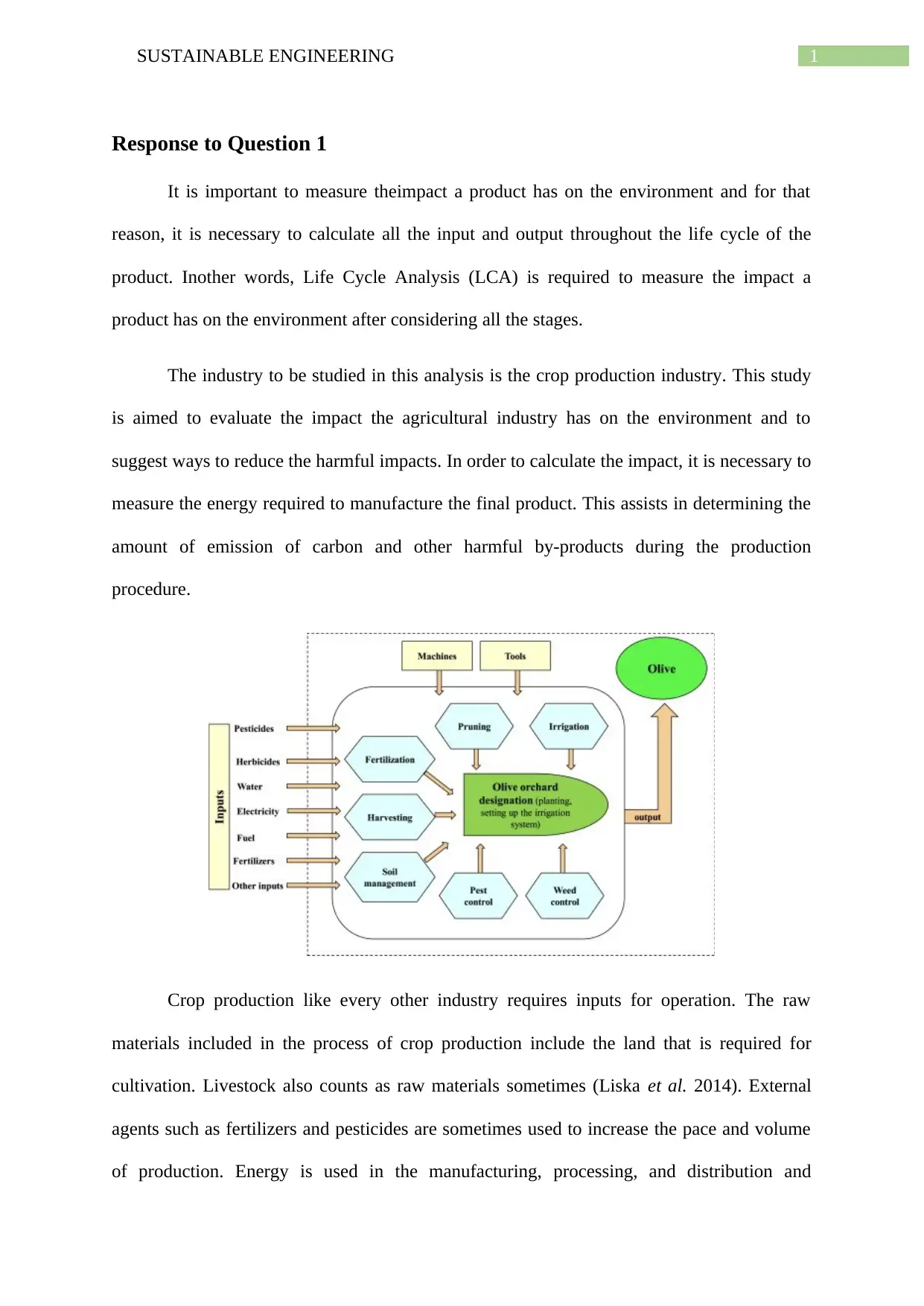
1SUSTAINABLE ENGINEERING
Response to Question 1
It is important to measure theimpact a product has on the environment and for that
reason, it is necessary to calculate all the input and output throughout the life cycle of the
product. Inother words, Life Cycle Analysis (LCA) is required to measure the impact a
product has on the environment after considering all the stages.
The industry to be studied in this analysis is the crop production industry. This study
is aimed to evaluate the impact the agricultural industry has on the environment and to
suggest ways to reduce the harmful impacts. In order to calculate the impact, it is necessary to
measure the energy required to manufacture the final product. This assists in determining the
amount of emission of carbon and other harmful by-products during the production
procedure.
Crop production like every other industry requires inputs for operation. The raw
materials included in the process of crop production include the land that is required for
cultivation. Livestock also counts as raw materials sometimes (Liska et al. 2014). External
agents such as fertilizers and pesticides are sometimes used to increase the pace and volume
of production. Energy is used in the manufacturing, processing, and distribution and
Response to Question 1
It is important to measure theimpact a product has on the environment and for that
reason, it is necessary to calculate all the input and output throughout the life cycle of the
product. Inother words, Life Cycle Analysis (LCA) is required to measure the impact a
product has on the environment after considering all the stages.
The industry to be studied in this analysis is the crop production industry. This study
is aimed to evaluate the impact the agricultural industry has on the environment and to
suggest ways to reduce the harmful impacts. In order to calculate the impact, it is necessary to
measure the energy required to manufacture the final product. This assists in determining the
amount of emission of carbon and other harmful by-products during the production
procedure.
Crop production like every other industry requires inputs for operation. The raw
materials included in the process of crop production include the land that is required for
cultivation. Livestock also counts as raw materials sometimes (Liska et al. 2014). External
agents such as fertilizers and pesticides are sometimes used to increase the pace and volume
of production. Energy is used in the manufacturing, processing, and distribution and
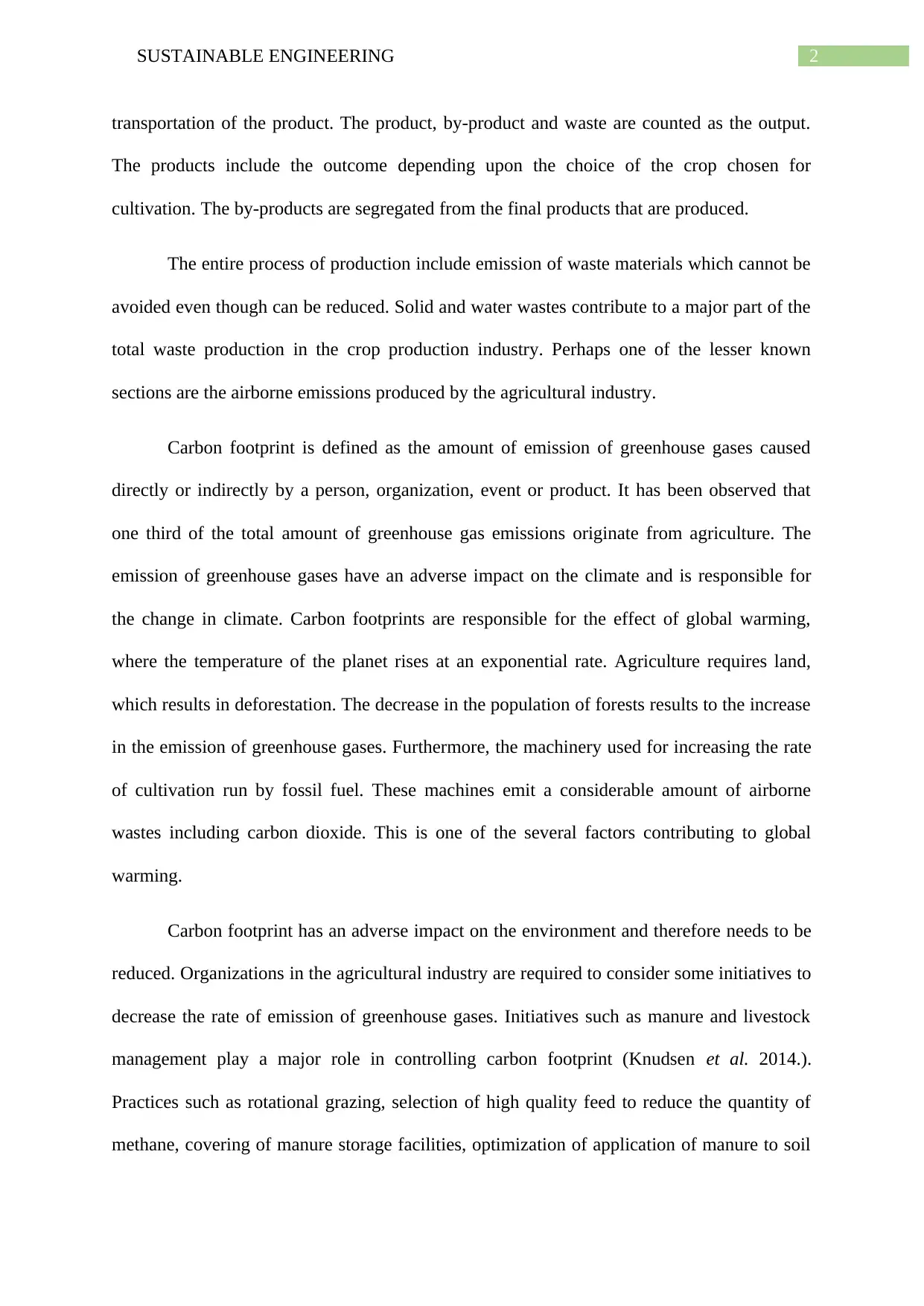
2SUSTAINABLE ENGINEERING
transportation of the product. The product, by-product and waste are counted as the output.
The products include the outcome depending upon the choice of the crop chosen for
cultivation. The by-products are segregated from the final products that are produced.
The entire process of production include emission of waste materials which cannot be
avoided even though can be reduced. Solid and water wastes contribute to a major part of the
total waste production in the crop production industry. Perhaps one of the lesser known
sections are the airborne emissions produced by the agricultural industry.
Carbon footprint is defined as the amount of emission of greenhouse gases caused
directly or indirectly by a person, organization, event or product. It has been observed that
one third of the total amount of greenhouse gas emissions originate from agriculture. The
emission of greenhouse gases have an adverse impact on the climate and is responsible for
the change in climate. Carbon footprints are responsible for the effect of global warming,
where the temperature of the planet rises at an exponential rate. Agriculture requires land,
which results in deforestation. The decrease in the population of forests results to the increase
in the emission of greenhouse gases. Furthermore, the machinery used for increasing the rate
of cultivation run by fossil fuel. These machines emit a considerable amount of airborne
wastes including carbon dioxide. This is one of the several factors contributing to global
warming.
Carbon footprint has an adverse impact on the environment and therefore needs to be
reduced. Organizations in the agricultural industry are required to consider some initiatives to
decrease the rate of emission of greenhouse gases. Initiatives such as manure and livestock
management play a major role in controlling carbon footprint (Knudsen et al. 2014.).
Practices such as rotational grazing, selection of high quality feed to reduce the quantity of
methane, covering of manure storage facilities, optimization of application of manure to soil
transportation of the product. The product, by-product and waste are counted as the output.
The products include the outcome depending upon the choice of the crop chosen for
cultivation. The by-products are segregated from the final products that are produced.
The entire process of production include emission of waste materials which cannot be
avoided even though can be reduced. Solid and water wastes contribute to a major part of the
total waste production in the crop production industry. Perhaps one of the lesser known
sections are the airborne emissions produced by the agricultural industry.
Carbon footprint is defined as the amount of emission of greenhouse gases caused
directly or indirectly by a person, organization, event or product. It has been observed that
one third of the total amount of greenhouse gas emissions originate from agriculture. The
emission of greenhouse gases have an adverse impact on the climate and is responsible for
the change in climate. Carbon footprints are responsible for the effect of global warming,
where the temperature of the planet rises at an exponential rate. Agriculture requires land,
which results in deforestation. The decrease in the population of forests results to the increase
in the emission of greenhouse gases. Furthermore, the machinery used for increasing the rate
of cultivation run by fossil fuel. These machines emit a considerable amount of airborne
wastes including carbon dioxide. This is one of the several factors contributing to global
warming.
Carbon footprint has an adverse impact on the environment and therefore needs to be
reduced. Organizations in the agricultural industry are required to consider some initiatives to
decrease the rate of emission of greenhouse gases. Initiatives such as manure and livestock
management play a major role in controlling carbon footprint (Knudsen et al. 2014.).
Practices such as rotational grazing, selection of high quality feed to reduce the quantity of
methane, covering of manure storage facilities, optimization of application of manure to soil
⊘ This is a preview!⊘
Do you want full access?
Subscribe today to unlock all pages.

Trusted by 1+ million students worldwide
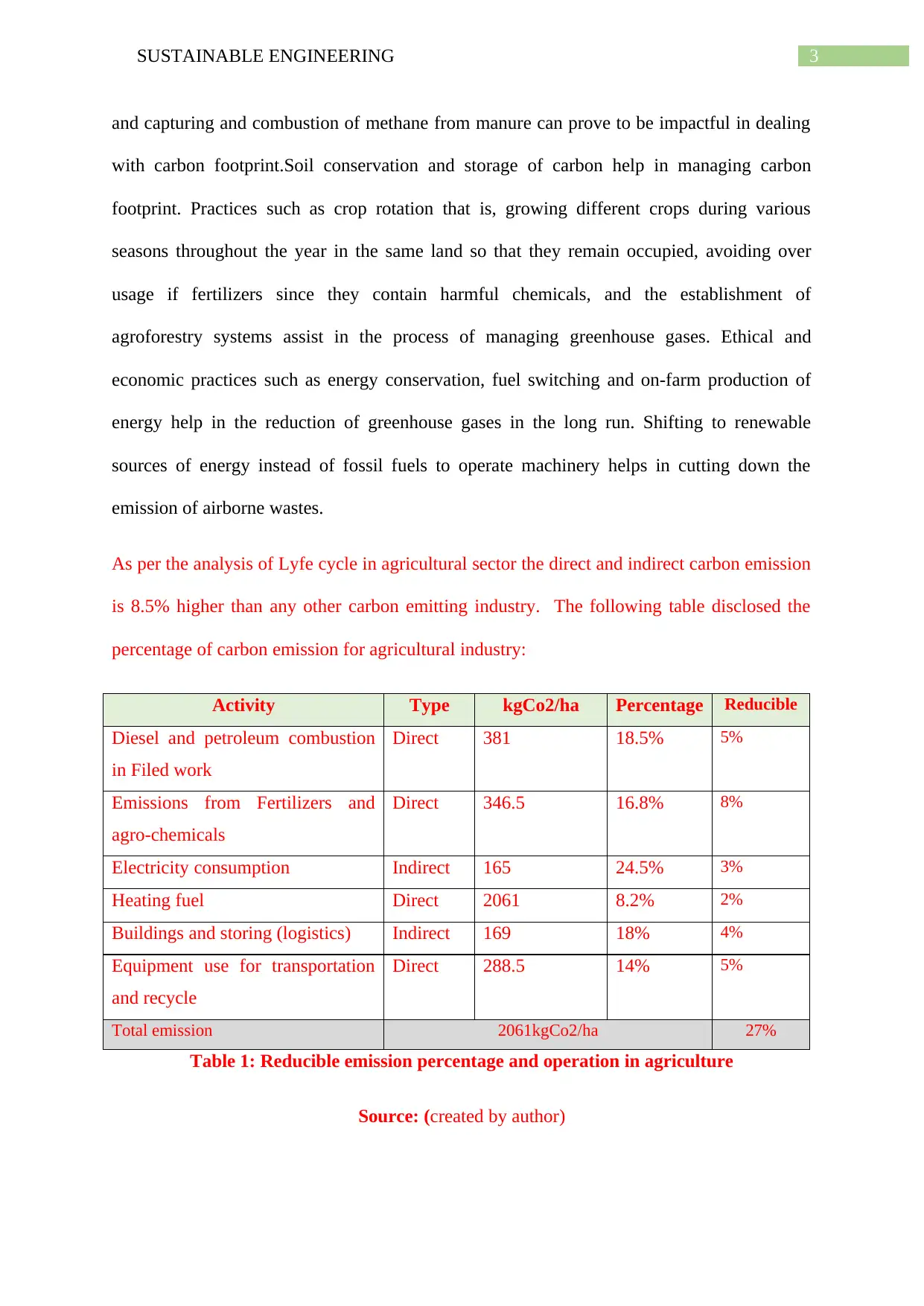
3SUSTAINABLE ENGINEERING
and capturing and combustion of methane from manure can prove to be impactful in dealing
with carbon footprint.Soil conservation and storage of carbon help in managing carbon
footprint. Practices such as crop rotation that is, growing different crops during various
seasons throughout the year in the same land so that they remain occupied, avoiding over
usage if fertilizers since they contain harmful chemicals, and the establishment of
agroforestry systems assist in the process of managing greenhouse gases. Ethical and
economic practices such as energy conservation, fuel switching and on-farm production of
energy help in the reduction of greenhouse gases in the long run. Shifting to renewable
sources of energy instead of fossil fuels to operate machinery helps in cutting down the
emission of airborne wastes.
As per the analysis of Lyfe cycle in agricultural sector the direct and indirect carbon emission
is 8.5% higher than any other carbon emitting industry. The following table disclosed the
percentage of carbon emission for agricultural industry:
Activity Type kgCo2/ha Percentage Reducible
Diesel and petroleum combustion
in Filed work
Direct 381 18.5% 5%
Emissions from Fertilizers and
agro-chemicals
Direct 346.5 16.8% 8%
Electricity consumption Indirect 165 24.5% 3%
Heating fuel Direct 2061 8.2% 2%
Buildings and storing (logistics) Indirect 169 18% 4%
Equipment use for transportation
and recycle
Direct 288.5 14% 5%
Total emission 2061kgCo2/ha 27%
Table 1: Reducible emission percentage and operation in agriculture
Source: (created by author)
and capturing and combustion of methane from manure can prove to be impactful in dealing
with carbon footprint.Soil conservation and storage of carbon help in managing carbon
footprint. Practices such as crop rotation that is, growing different crops during various
seasons throughout the year in the same land so that they remain occupied, avoiding over
usage if fertilizers since they contain harmful chemicals, and the establishment of
agroforestry systems assist in the process of managing greenhouse gases. Ethical and
economic practices such as energy conservation, fuel switching and on-farm production of
energy help in the reduction of greenhouse gases in the long run. Shifting to renewable
sources of energy instead of fossil fuels to operate machinery helps in cutting down the
emission of airborne wastes.
As per the analysis of Lyfe cycle in agricultural sector the direct and indirect carbon emission
is 8.5% higher than any other carbon emitting industry. The following table disclosed the
percentage of carbon emission for agricultural industry:
Activity Type kgCo2/ha Percentage Reducible
Diesel and petroleum combustion
in Filed work
Direct 381 18.5% 5%
Emissions from Fertilizers and
agro-chemicals
Direct 346.5 16.8% 8%
Electricity consumption Indirect 165 24.5% 3%
Heating fuel Direct 2061 8.2% 2%
Buildings and storing (logistics) Indirect 169 18% 4%
Equipment use for transportation
and recycle
Direct 288.5 14% 5%
Total emission 2061kgCo2/ha 27%
Table 1: Reducible emission percentage and operation in agriculture
Source: (created by author)
Paraphrase This Document
Need a fresh take? Get an instant paraphrase of this document with our AI Paraphraser
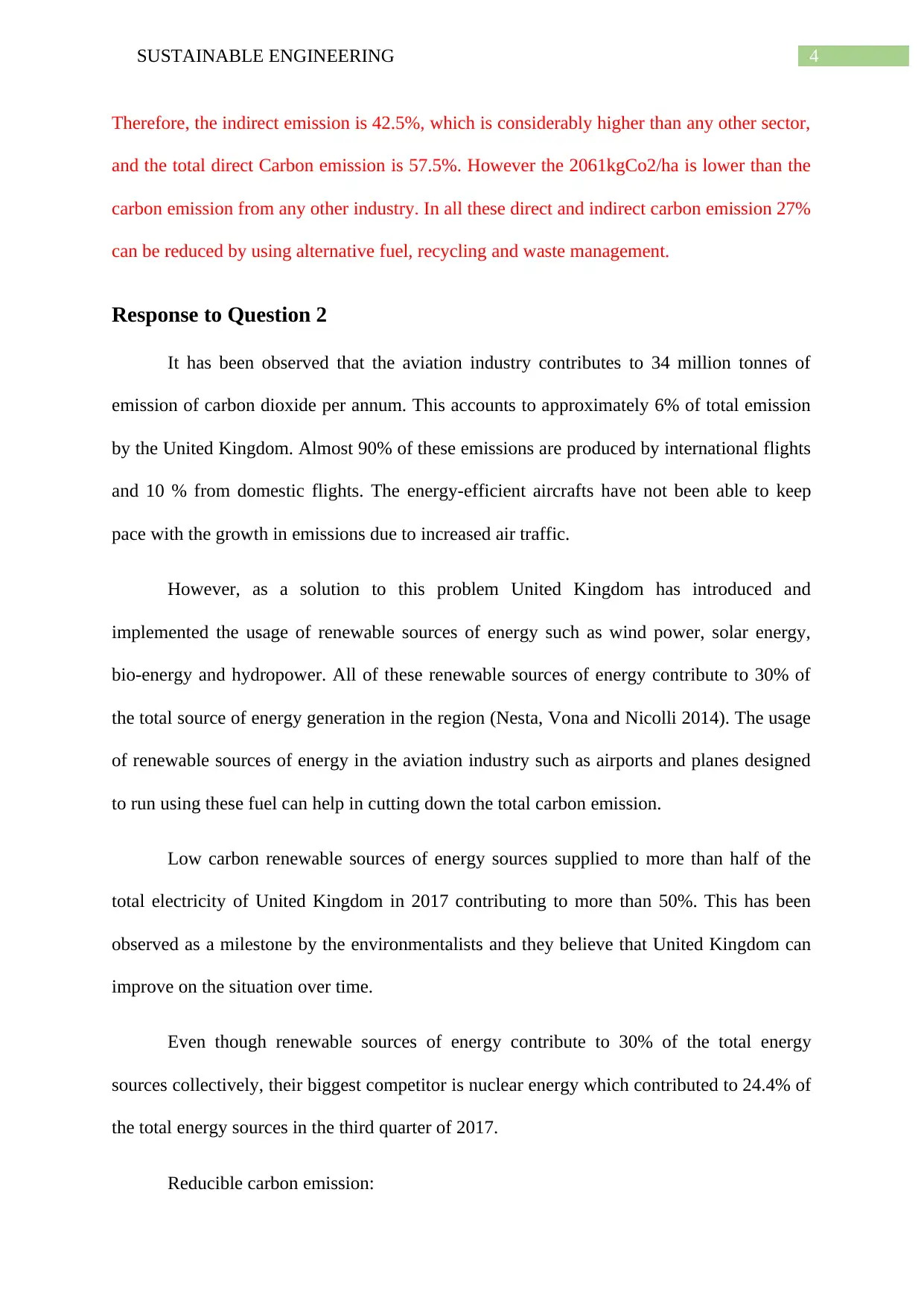
4SUSTAINABLE ENGINEERING
Therefore, the indirect emission is 42.5%, which is considerably higher than any other sector,
and the total direct Carbon emission is 57.5%. However the 2061kgCo2/ha is lower than the
carbon emission from any other industry. In all these direct and indirect carbon emission 27%
can be reduced by using alternative fuel, recycling and waste management.
Response to Question 2
It has been observed that the aviation industry contributes to 34 million tonnes of
emission of carbon dioxide per annum. This accounts to approximately 6% of total emission
by the United Kingdom. Almost 90% of these emissions are produced by international flights
and 10 % from domestic flights. The energy-efficient aircrafts have not been able to keep
pace with the growth in emissions due to increased air traffic.
However, as a solution to this problem United Kingdom has introduced and
implemented the usage of renewable sources of energy such as wind power, solar energy,
bio-energy and hydropower. All of these renewable sources of energy contribute to 30% of
the total source of energy generation in the region (Nesta, Vona and Nicolli 2014). The usage
of renewable sources of energy in the aviation industry such as airports and planes designed
to run using these fuel can help in cutting down the total carbon emission.
Low carbon renewable sources of energy sources supplied to more than half of the
total electricity of United Kingdom in 2017 contributing to more than 50%. This has been
observed as a milestone by the environmentalists and they believe that United Kingdom can
improve on the situation over time.
Even though renewable sources of energy contribute to 30% of the total energy
sources collectively, their biggest competitor is nuclear energy which contributed to 24.4% of
the total energy sources in the third quarter of 2017.
Reducible carbon emission:
Therefore, the indirect emission is 42.5%, which is considerably higher than any other sector,
and the total direct Carbon emission is 57.5%. However the 2061kgCo2/ha is lower than the
carbon emission from any other industry. In all these direct and indirect carbon emission 27%
can be reduced by using alternative fuel, recycling and waste management.
Response to Question 2
It has been observed that the aviation industry contributes to 34 million tonnes of
emission of carbon dioxide per annum. This accounts to approximately 6% of total emission
by the United Kingdom. Almost 90% of these emissions are produced by international flights
and 10 % from domestic flights. The energy-efficient aircrafts have not been able to keep
pace with the growth in emissions due to increased air traffic.
However, as a solution to this problem United Kingdom has introduced and
implemented the usage of renewable sources of energy such as wind power, solar energy,
bio-energy and hydropower. All of these renewable sources of energy contribute to 30% of
the total source of energy generation in the region (Nesta, Vona and Nicolli 2014). The usage
of renewable sources of energy in the aviation industry such as airports and planes designed
to run using these fuel can help in cutting down the total carbon emission.
Low carbon renewable sources of energy sources supplied to more than half of the
total electricity of United Kingdom in 2017 contributing to more than 50%. This has been
observed as a milestone by the environmentalists and they believe that United Kingdom can
improve on the situation over time.
Even though renewable sources of energy contribute to 30% of the total energy
sources collectively, their biggest competitor is nuclear energy which contributed to 24.4% of
the total energy sources in the third quarter of 2017.
Reducible carbon emission:
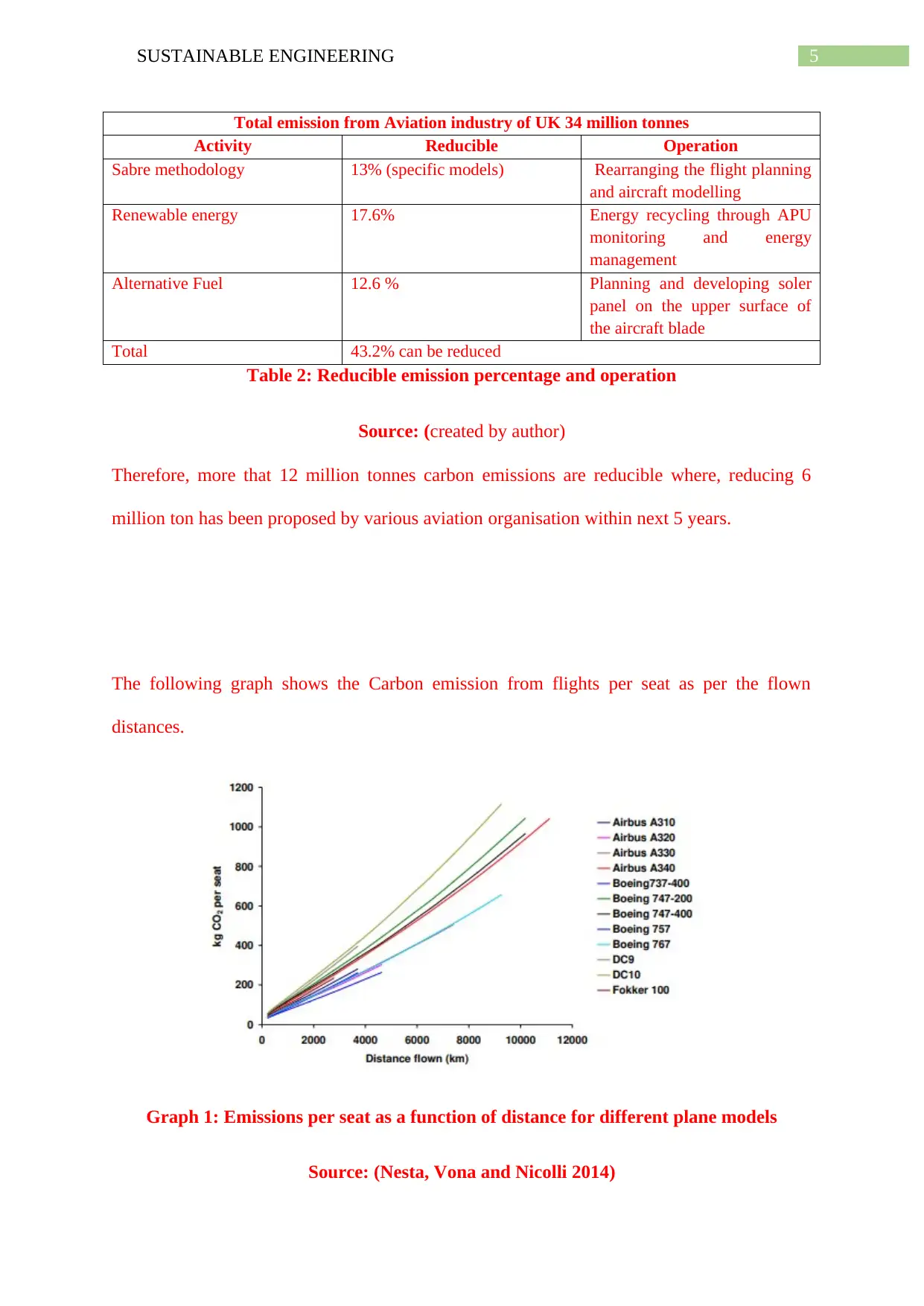
5SUSTAINABLE ENGINEERING
Total emission from Aviation industry of UK 34 million tonnes
Activity Reducible Operation
Sabre methodology 13% (specific models) Rearranging the flight planning
and aircraft modelling
Renewable energy 17.6% Energy recycling through APU
monitoring and energy
management
Alternative Fuel 12.6 % Planning and developing soler
panel on the upper surface of
the aircraft blade
Total 43.2% can be reduced
Table 2: Reducible emission percentage and operation
Source: (created by author)
Therefore, more that 12 million tonnes carbon emissions are reducible where, reducing 6
million ton has been proposed by various aviation organisation within next 5 years.
The following graph shows the Carbon emission from flights per seat as per the flown
distances.
Graph 1: Emissions per seat as a function of distance for different plane models
Source: (Nesta, Vona and Nicolli 2014)
Total emission from Aviation industry of UK 34 million tonnes
Activity Reducible Operation
Sabre methodology 13% (specific models) Rearranging the flight planning
and aircraft modelling
Renewable energy 17.6% Energy recycling through APU
monitoring and energy
management
Alternative Fuel 12.6 % Planning and developing soler
panel on the upper surface of
the aircraft blade
Total 43.2% can be reduced
Table 2: Reducible emission percentage and operation
Source: (created by author)
Therefore, more that 12 million tonnes carbon emissions are reducible where, reducing 6
million ton has been proposed by various aviation organisation within next 5 years.
The following graph shows the Carbon emission from flights per seat as per the flown
distances.
Graph 1: Emissions per seat as a function of distance for different plane models
Source: (Nesta, Vona and Nicolli 2014)
⊘ This is a preview!⊘
Do you want full access?
Subscribe today to unlock all pages.

Trusted by 1+ million students worldwide
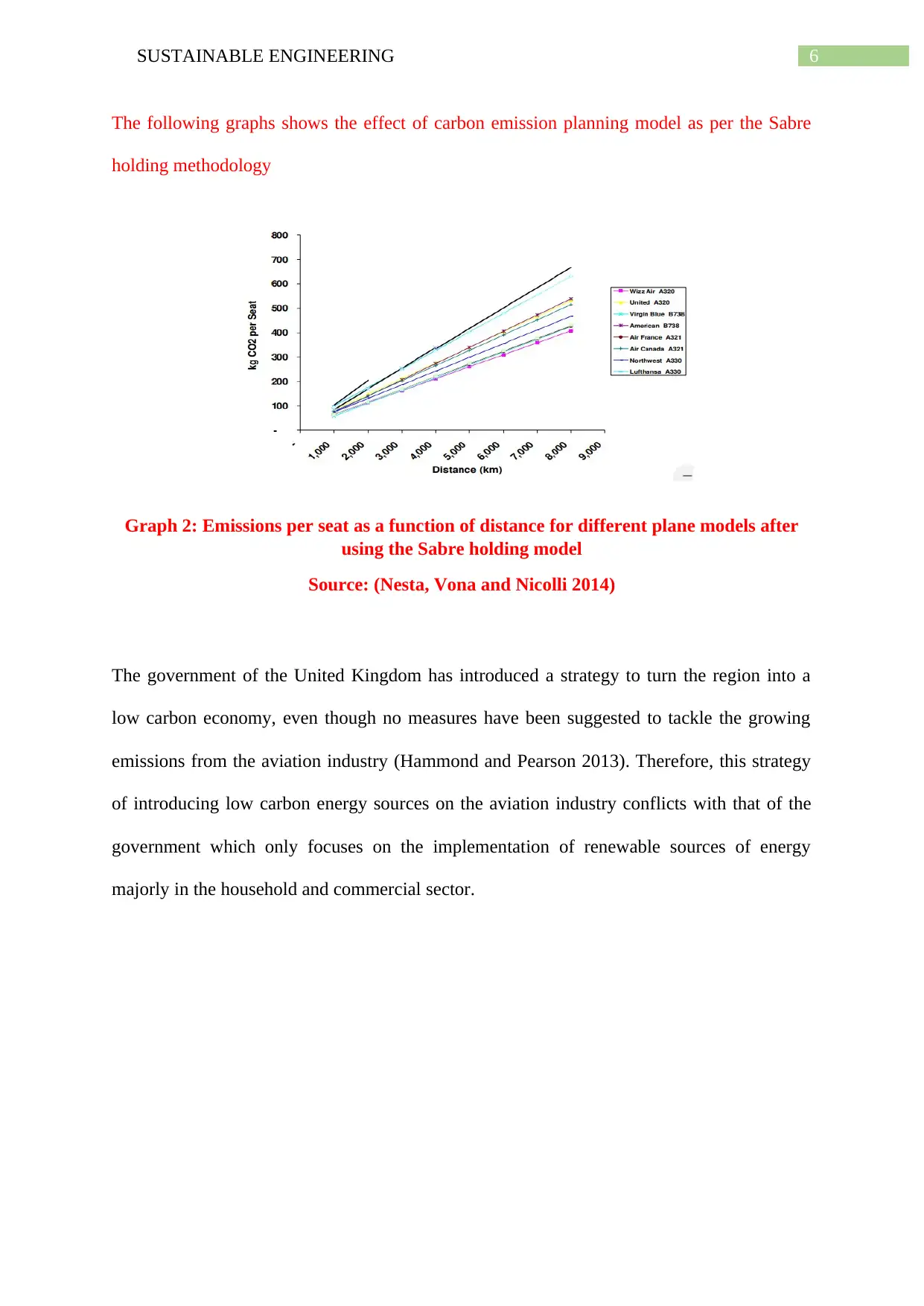
6SUSTAINABLE ENGINEERING
The following graphs shows the effect of carbon emission planning model as per the Sabre
holding methodology
Graph 2: Emissions per seat as a function of distance for different plane models after
using the Sabre holding model
Source: (Nesta, Vona and Nicolli 2014)
The government of the United Kingdom has introduced a strategy to turn the region into a
low carbon economy, even though no measures have been suggested to tackle the growing
emissions from the aviation industry (Hammond and Pearson 2013). Therefore, this strategy
of introducing low carbon energy sources on the aviation industry conflicts with that of the
government which only focuses on the implementation of renewable sources of energy
majorly in the household and commercial sector.
The following graphs shows the effect of carbon emission planning model as per the Sabre
holding methodology
Graph 2: Emissions per seat as a function of distance for different plane models after
using the Sabre holding model
Source: (Nesta, Vona and Nicolli 2014)
The government of the United Kingdom has introduced a strategy to turn the region into a
low carbon economy, even though no measures have been suggested to tackle the growing
emissions from the aviation industry (Hammond and Pearson 2013). Therefore, this strategy
of introducing low carbon energy sources on the aviation industry conflicts with that of the
government which only focuses on the implementation of renewable sources of energy
majorly in the household and commercial sector.
Paraphrase This Document
Need a fresh take? Get an instant paraphrase of this document with our AI Paraphraser
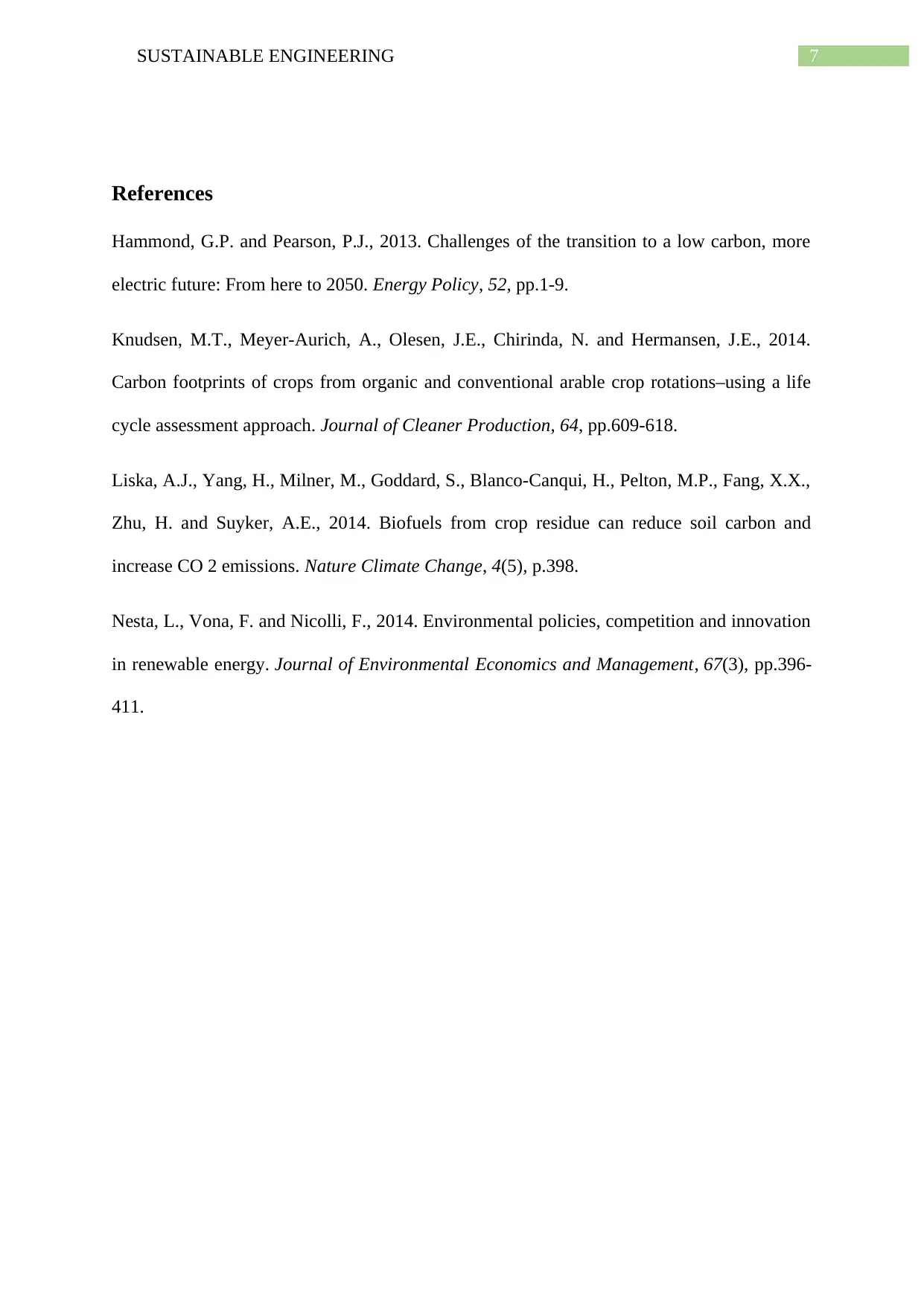
7SUSTAINABLE ENGINEERING
References
Hammond, G.P. and Pearson, P.J., 2013. Challenges of the transition to a low carbon, more
electric future: From here to 2050. Energy Policy, 52, pp.1-9.
Knudsen, M.T., Meyer-Aurich, A., Olesen, J.E., Chirinda, N. and Hermansen, J.E., 2014.
Carbon footprints of crops from organic and conventional arable crop rotations–using a life
cycle assessment approach. Journal of Cleaner Production, 64, pp.609-618.
Liska, A.J., Yang, H., Milner, M., Goddard, S., Blanco-Canqui, H., Pelton, M.P., Fang, X.X.,
Zhu, H. and Suyker, A.E., 2014. Biofuels from crop residue can reduce soil carbon and
increase CO 2 emissions. Nature Climate Change, 4(5), p.398.
Nesta, L., Vona, F. and Nicolli, F., 2014. Environmental policies, competition and innovation
in renewable energy. Journal of Environmental Economics and Management, 67(3), pp.396-
411.
References
Hammond, G.P. and Pearson, P.J., 2013. Challenges of the transition to a low carbon, more
electric future: From here to 2050. Energy Policy, 52, pp.1-9.
Knudsen, M.T., Meyer-Aurich, A., Olesen, J.E., Chirinda, N. and Hermansen, J.E., 2014.
Carbon footprints of crops from organic and conventional arable crop rotations–using a life
cycle assessment approach. Journal of Cleaner Production, 64, pp.609-618.
Liska, A.J., Yang, H., Milner, M., Goddard, S., Blanco-Canqui, H., Pelton, M.P., Fang, X.X.,
Zhu, H. and Suyker, A.E., 2014. Biofuels from crop residue can reduce soil carbon and
increase CO 2 emissions. Nature Climate Change, 4(5), p.398.
Nesta, L., Vona, F. and Nicolli, F., 2014. Environmental policies, competition and innovation
in renewable energy. Journal of Environmental Economics and Management, 67(3), pp.396-
411.
1 out of 8
Related Documents
Your All-in-One AI-Powered Toolkit for Academic Success.
+13062052269
info@desklib.com
Available 24*7 on WhatsApp / Email
![[object Object]](/_next/static/media/star-bottom.7253800d.svg)
Unlock your academic potential
Copyright © 2020–2025 A2Z Services. All Rights Reserved. Developed and managed by ZUCOL.





